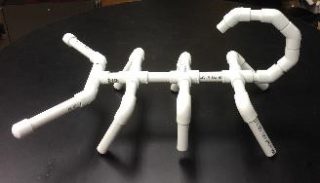 Ed Clausen, March 2018 Wally Cordes Chair, Associate Department Head, and Professor in the College of Engineering, led a discussion on engaging students in the large classroom titled, “How Can We Reach Students, Particularly in Large Classrooms?” In this discussion Dr. Clausen shared his methods for student engagement that included some innovative assignments and activities, as well as some simple methods for creating a rapport with students.
Ed Clausen, March 2018 Wally Cordes Chair, Associate Department Head, and Professor in the College of Engineering, led a discussion on engaging students in the large classroom titled, “How Can We Reach Students, Particularly in Large Classrooms?” In this discussion Dr. Clausen shared his methods for student engagement that included some innovative assignments and activities, as well as some simple methods for creating a rapport with students.
Clausen’s goal is to have students comfortable in the classroom, comfortable with him as an instructor, with each other, and with themselves. He does this by fostering communication both inside and out of the classroom.
Some of the ideas that Dr. Clausen shared were:
- Utilize ice breaker sort of activities that encourage discussion. For example, he tells students to “find someone different than you” and does not define what he means. Then he asks them to “discuss what you have in common.” This initiates conversations among students who may think they are different but are really not very different at all.
- He has what he calls the “homework table” which is a table in his office with the answers to homework assignments. He allows students to come in, look at the answers, and ask any questions they may have. When students come, he asks them questions about how they are doing in the class and if they are understanding the material. This goes a beyond the typical office hour and provides more incentive for coming to his office.
- “Ever see that glossed over look or the look of total boredom?” It may be time to “Pause for a story.” Clausen relies on humorous anecdotes from his life to reengage students or asks questions about campus events, such as the Razorbacks. He notes that these stories need to be entertaining in order to gather students attention. But keep it short!
- He also provides an in class review session for students the class before the exams. This allows those students who are struggling to ask for help. The in class scheduled review sessions seem to work better than after hours extra study sessions because it is already built into student schedules.
- In his engineering class he had students do a creative activity together in groups. He supplies materials (pvc pipe, fittings, and tubing cutters) and tells them to build a scorpion. (Specific information and more examples of student work can be found in the attachment below.) Here is an example:

When the floor was open for discussion, several other instructors supplied methods for engaging students in large lecture-style classes.
Some of the other examples included:
- Learn the names of the students and something about them, or at least those who are actively engaged in the course (in a 400+ course it may not be possible to learn ALL of their names!). This gives some accountability or a sense of accountability to the students.
- Walk around the classroom, especially in a large lecture room. Use a microphone and walk around to visit with more students. You cannot engage every student but you can involve more than just the front row.
- Keep it interactive. Have group work or use a “flipped class” method and do “pop-up lectures” on concepts that many students seem to be having trouble with. These “pop-up lectures” can be 10-15 minute mini lectures.
- Recognize that what may work one semester may not work in another. Classes have “personalities.”
- Have them talk to each other. Have them discuss answers in small groups before returning to the whole class.
- Use theme music! If it is the holidays or if you are covering a topic that is mentioned in a song, play it as they come in!
- Give bonus points, create competition for fastest (correct) answer to questions.
- Give bonus points if they catch you making a mistake!
- Use jokes, humor, cartoons, images in PowerPoint.
- Have them give you jokes and tell them in class.
For more information on Dr. Clausen’s methods, the presentation can be downloaded and viewed as a PDF: Ed Clausen Cordes Chair Presentation
or you can email him at eclause@uark.edu
This content was developed from a presentation by which was sponsored by the The Wally Cordes Teaching and Faculty Support Center (TFSC) at the University of Arkansas.